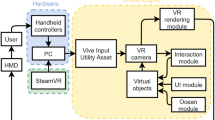Abstract
In this study, a 3D virtual reality and visualization engine for rendering the ocean, named VV-Ocean, is designed for marine applications. The design goals of VV-Ocean aim at high fidelity simulation of ocean environment, visualization of massive and multidimensional marine data, and imitation of marine lives. VV-Ocean is composed of five modules, i.e. memory management module, resources management module, scene management module, rendering process management module and interaction management module. There are three core functions in VV-Ocean: reconstructing vivid virtual ocean scenes, visualizing real data dynamically in real time, imitating and simulating marine lives intuitively. Based on VV-Ocean, we establish a sea-land integration platform which can reproduce drifting and diffusion processes of oil spilling from sea bottom to surface. Environment factors such as ocean current and wind field have been considered in this simulation. On this platform oil spilling process can be abstracted as movements of abundant oil particles. The result shows that oil particles blend with water well and the platform meets the requirement for real-time and interactive rendering. VV-Ocean can be widely used in ocean applications such as demonstrating marine operations, facilitating maritime communications, developing ocean games, reducing marine hazards, forecasting the weather over oceans, serving marine tourism, and so on. Finally, further technological improvements of VV-Ocean are discussed.
Similar content being viewed by others
References
Bao, K., Wu, X. L., Zhang, H., and Wu, E. H., 2011. Volume fraction based miscible and immiscible fluid animation. Computer Animation and Virtual Worlds, 21: 401–410.
Chang, R., Ghoniem, M., Kosara, R., Ribarsky, W., Yang, J., Suma, E., Ziemkiewicz, C., Kern, D., and Sudjianto, A., 2007. WireVis: Visualization of categorical, time-varying data from financial transactions. Proceedings of the 2007 IEEE Symposium on Visual Analytics Science and Technology (VAST ′07). University of North Carolina, Charlotte, 155–162.
Chen, G., Li, W. Q., Kong, Q. Q., Liu, S. X., Lv, C. J., and Tian, F. L., 2012. Recent progress of marine geographic information system in China: A review for 2006–2010. Journal of Ocean University of China, 11(1): 18–24.
Claes, J., 2004. Real time water rendering. Master thesis. Department of Computer Science, Lund University.
Fay, J. A., 1969. The spread of oil slicks on a calm sea. In: Oil on the Sea. Hoult, D. P., ed., Plenum Press, New York, 53–63.
Gary, A. M., Peter, A. W., and John, F. M., 1987. Fourier Synthesis of Ocean Scenes. IEEE Computer Graphics and Applications, 16–23.
Jerry, T., 2001. Simulating ocean water. ACM SIGGRAPH (Special Interest Group on Computer Graphics) 2001 Ccourse Notes, http://home1.get.net/tssndrf/.
Li, S., Wang, G. P., and Wu, E. H., 2008. A new approach for construction and rendering of dynamic light shaft. Computers and Graphics, 32(6): 660–668.
Liu, F., Hua, W., and Bao, H. J., 2010. Quad mesh based dynamic simulation of large-scale forest on GPU. Journal of Computer-Aided Design and Computer Graphics, 22(10): 1701–1708.
Ma, C. Y., Chen, G., Han, Y., Qi, Y. Y., and Chen. Y., 2010. An integrated VR-GIS navigation platform for city/region simulation. Computer Animation and Virtual Worlds, 21: 499–507.
Mahesh, S., Tim, F., Costas, E., and Matthias, W., 2009. Skeleton-based rigid skinning for character animation. In: 4th International Conference on Computer Graphics Theory and Applications. Lisboa, Portugal, 302–308.
Ripolles, O., Ramos, F., Puig-Centelles, A., and Chover, M., 2012. Real-time tessellation of terrain on graphics hardware. Computers and Geosciences, 41: 147–155.
Shi, S. X., and Lei, B., 2011. Theory and Practice on China Digital Ocean. Ocean Press, Beijing, 80–100.
Tian, F. L., Hua, W., Dong, Z. L., and Bao, H. J., 2010. Adaptive voxels, interactive rendering of massive 3D models. The Visual Computer, 26(6–8): 409–419.
Wang, S. D., Cai, K. Y., Lu, J., Liu, X. H., and Wu, E. H., 2010. Real-time coherent stylization for augmented reality. Visual Computer, 26(6–8): 445–455.
Zhang, F., Li, H. Q., Liu, J., and Li, S. H., 2011. Research and realization of visual digital ocean system. Marine Science Bulletin, 13(1): 87–96.
Zhao, S. P., 2009. A survey of activities in virtual reality. Science in China Series F: Information Sciences, 39(1): 2–46.
Author information
Authors and Affiliations
Corresponding author
Rights and permissions
About this article
Cite this article
Chen, G., Li, B., Tian, F. et al. Design and implementation of a 3D ocean virtual reality and visualization engine. J. Ocean Univ. China 11, 481–487 (2012). https://doi.org/10.1007/s11802-012-2112-6
Received:
Revised:
Accepted:
Published:
Issue Date:
DOI: https://doi.org/10.1007/s11802-012-2112-6




